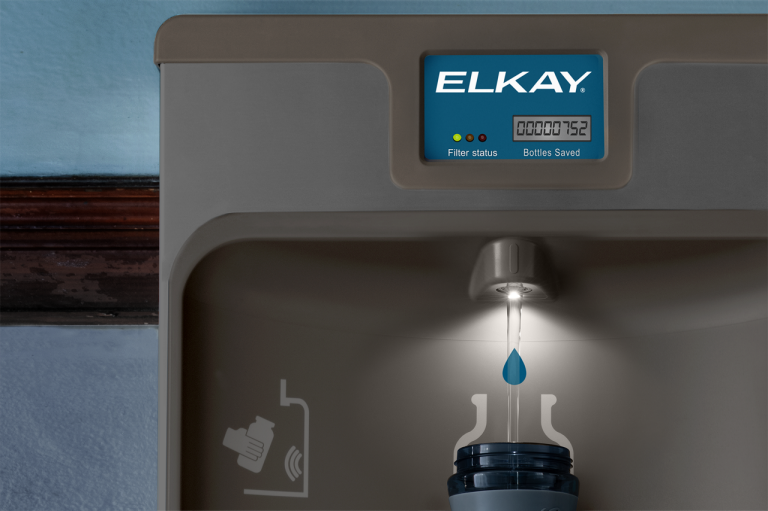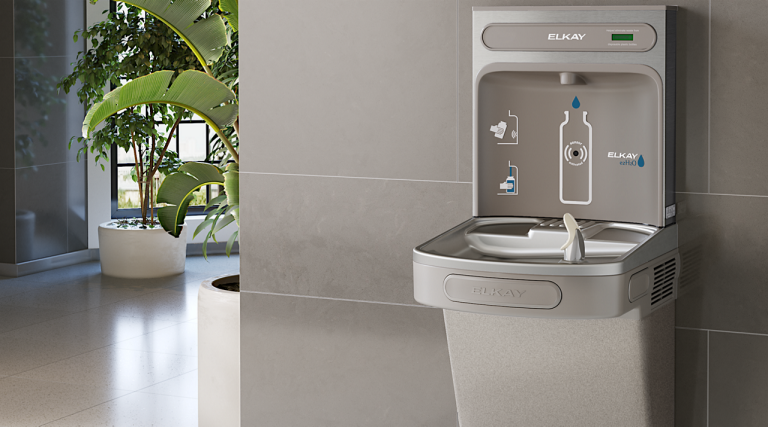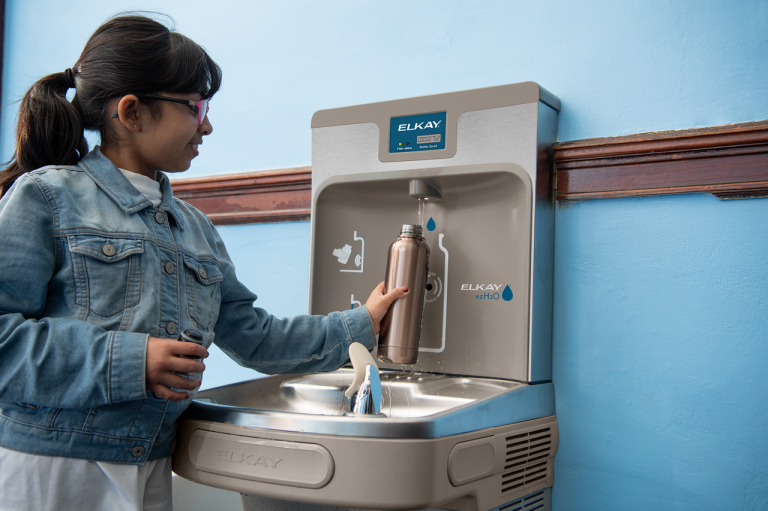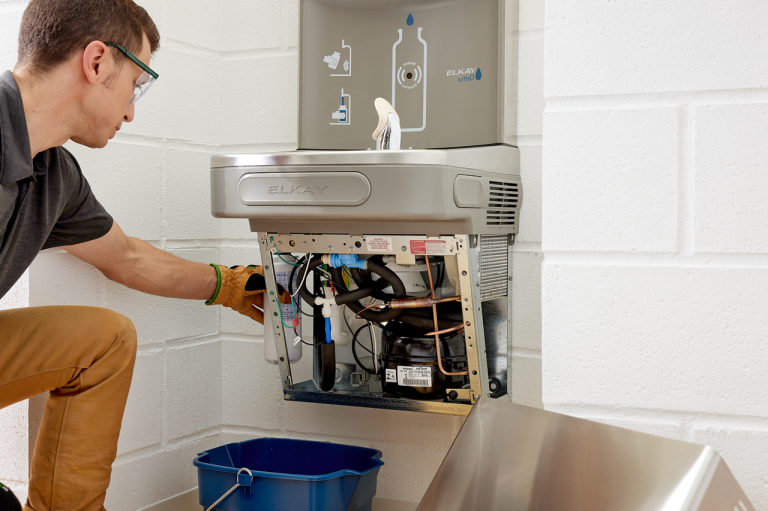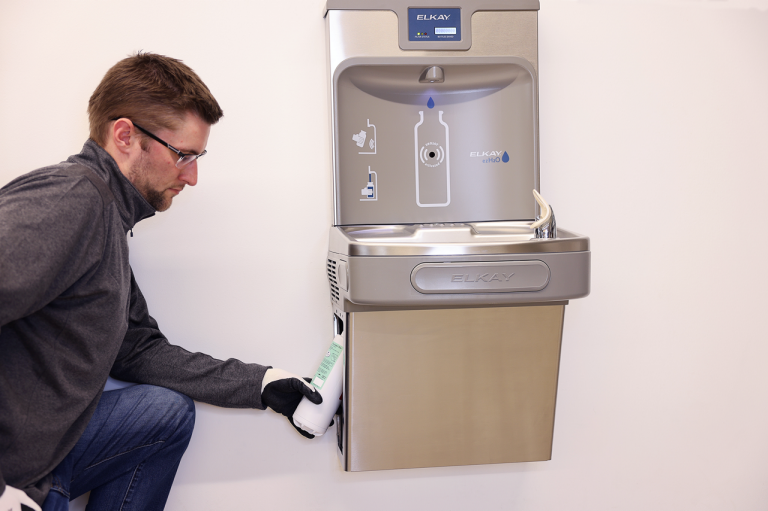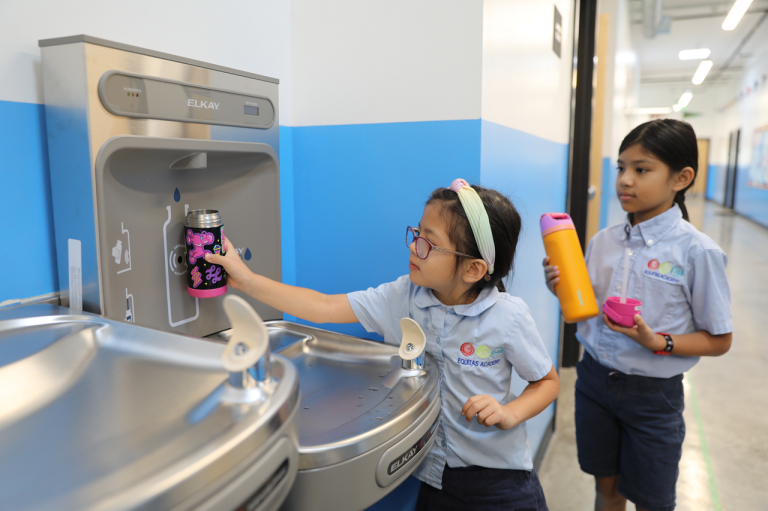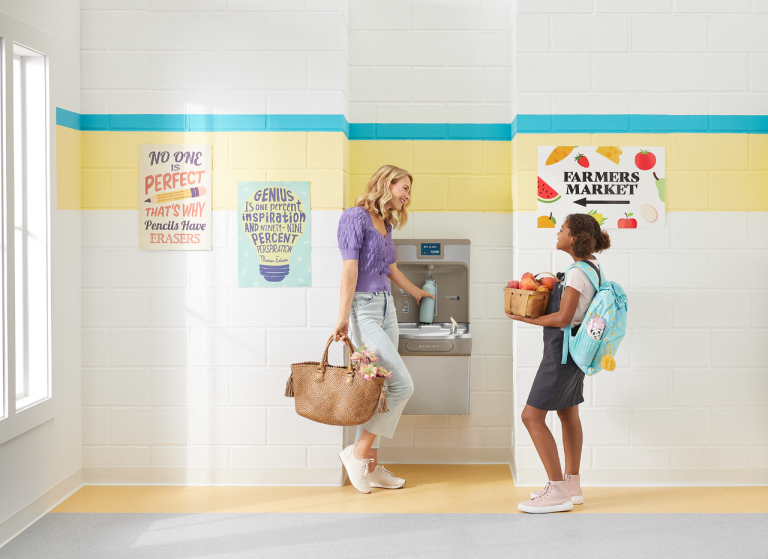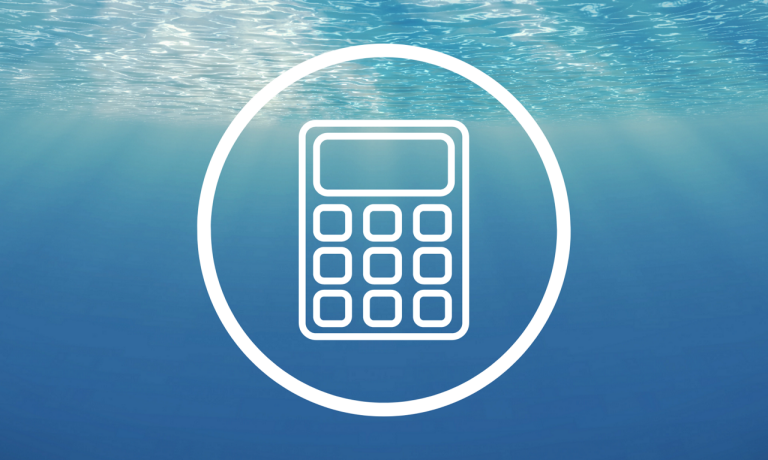Bring safer drinking water to your school.

New Jersey Schools! Need Help with Your DOE Drinking Water Grant Application?
Watch How Filtration Transforms Schools
Filtration as a Solution
Elkay ezH2O® filtered bottle filling stations are ideal solutions for schools because they reduce lead and other contaminants, delivering safer water kids will want to drink.
Select a benefit to learn more.
Do you know which bottle fillers have the “yucky” water? Students do. Watch how a principal found out his bottle fillers weren’t filtered like he assumed, and how Elkay helped him bring cleaner, healthier water to his students with limited impact on the maintenance team.
- Facilities Managers
- Parents/Guardians
- Teachers/Administrators
Facilities Managers
- Know your state’s school drinking water requirements. Many states have bills in process while others now have laws in place to test school drinking water and remediate. Make sure you’re familiar with your state’s legislation.
- Stay steps ahead and make upgrades now. Elkay has a broad portfolio of award-winning bottle filling stations that meet state and NSF/ANSI standards.
- Choose from a variety of installations. There are on-wall, in-wall and even floor standing ezH2O® bottle filling stations, as well as retrofit kits that transform existing drinking fountains into filtered bottle filling stations.
- Change filters faster with our EZ Filter Maintenance Kit. Retrofit it to any single-level filtered cooler or bottle filling station, and replace filters more efficiently through the easy access panel.
- Plus, get quality construction and customer service with our bottle filling stations.
- Choose from a variety of installations. There are on-wall, in-wall and even floor standing ezH2O® bottle filling stations, as well as retrofit kits that transform existing drinking fountains into filtered bottle filling stations.
- Keep installation simple. Install single bottle filling station and cooler combos without worrying about drywalling. Instead, cover wall imperfections and retrofit wall work with our stainless steel back panel, which also provide some splash protection for gypsum sheetrock walls. Other accessories, like our remote chiller, can be added later to refrigerate an existing cooler.
- Add filtration to classrooms and more. Upgrade classroom sinks with the universal vandal-resistant filtration kit and install ezH2O Liv® Pro water dispensers in teacher’s lounges.
- Maintain safer water more easily.
- Ensure there’s always access to filtered water by replacing filters regularly, which will also keep the status light green.
- Find your correct replacement filter using our handy filter tool, and save time reordering by enrolling in our filter subscription plan. Elkay products work best with Elkay filters — beware of counterfeits.
- Skip the guesswork and watch our installation videos. Learn how to install bottle filling stations, coolers and filters.
- Let us help you! Complete our form to learn more or set up a free facility walkthrough.
- Or purchase in person. Explore where to buy Elkay drinking water products near you.
- Show off your success! Share on social media the impact of your new products, how you’re meeting goals, and helpful tips for maintaining these products. You can inspire others who might think cleaner drinking water is unattainable.
Parents and Guardians
- Send this letter to your PTA. Explain your school’s poor water conditions and how it could harm your child’s health and performance. We can help you advocate for better access to filtered drinking water.
- Share the facts. Use social media to spread the word to your friends and community. Bring awareness to lead in drinking water and how your people can inspire their decision makers.
- Equip yourself. Bring the right tools to your next school board meeting. We’ll help you feel confident in presenting a case to your decision makers.
- Check your state or county’s water quality and print those results.
- Share EPA standards for lead found in this white paper.
- Provide this recent success story we developed for the Equitas 3 school in Los Angeles.
- Show your school board the solution — our ezH2O® filtered bottle filling station.
- Check your state or county’s water quality and print those results.
- Let us help you! Complete our form to learn more about which solutions are right for your school.
Teachers and Administrators
- Know more, teach more.
- The more you know about lead, the better equipped you’ll be to teach your students about it. And the more you know about ezH2O® filtered bottle filling stations, the better you can advocate for your students.
- Learn how filtration can help fix lead in drinking water.
- Read this success story for inspiration and help for building a case for your school.
- Download this fun activity that educates students about filtration.
- Provide students with this letter they can complete to request cleaner drinking water from their principal.
- If you already have a bottle filling station, check to see if it has these lights to know it’s a filtered unit.
If the light is yellow, it’s time to replace the filter — don’t wait for it to turn red.

- Influence your principal. Together, you, other staff members and parents can bring a case to your principal and school board. Show them the solution and all its benefits. Share what you know and fight for your school’s health at your next school board meeting.
- Spread the word. Share what you’ve learned with your peers and community on social media. This could help you gain more support and spark fundraising ideas.
- Let us help you! Fill out this brief form and someone will get in touch with you.
Browse Healthier Solutions for Your School
Learn more about filtered water solutions, hygienic restroom fixtures and other Health Smart products from Zurn Elkay.
Lead Is a Nationwide Issue
“Lead is contaminating drinking water at schools and preschools across the country." 1
Click the map to view lead levels by state and to view the full article
Click the map to view lead levels by state and to view the full article
| Most significant data on lead in schools' water | |
| Data from relatively few school districts so far | |
| Testing program announced but little or no data available yet |
| Most significant data on lead in schools' water | |
| Data from relatively few school districts so far | |
| Testing program announced but little or no data available yet |
Click the map to view lead levels by state and to view the full article
Click the map to view lead levels by state and to view the full article
Don’t Let Lead Go Untreated
- Lead exposure in children has been linked to damage to the central nervous and peripheral nervous system, learning disabilities, and even anxiety.
- If kids avoid drinking their school’s water all together, they could become dehydrated, impacting their cognitive performance. 2
FAQs
Do Elkay drinking fountains include filtration?
Some Elkay drinking fountains come with optional filtration to reduce lead, chlorine, and particulates. Models that include filtration are clearly marked and use NSF-certified filters.
How do Elkay fountains help improve water quality?
Models with filtration use NSF-certified filters to reduce contaminants like lead and chlorine, improving both taste and safety.
What is the process of retrofitting old fountains with bottle fillers?
Retrofitting an old water fountain with a bottle filler involves installing a conversion kit that connects to the existing plumbing and electrical supply. The process starts with preparation—verifying model compatibility, shutting off water and power, and removing access panels. Next, the plumbing is reconfigured by disconnecting the bubbler line, installing a T-connector, and attaching new water lines (plus a drain if required). The bottle filler is then mounted using a bracket, connected to wiring for sensors or controls, and tested for leaks and proper function after utilities are restored. Finally, the panels are reattached to complete the installation. While retrofit kits from brands like Elkay, Oasis, and Haws simplify the process, consulting the manufacturer’s manual is essential to ensure correct installation.
What options are available for retrofitting existing water fountains?
The main way to retrofit an existing fountain is by adding a bottle-filling station through a retrofit kit, which can also include built-in filtration. These kits provide touchless activation, filter status lights, smooth laminar flow, and features like Elkay’s Green Ticker™ to track bottles saved. Compatibility depends on the fountain’s manufacturer, model, and age, with options for both wall-mounted and recessed units. If the fountain is chilled, the cooling carries over, while older models may not be ideal for retrofitting. Alternatives include installing a surface-mount bottle filler near the fountain, adding a separate filtration unit, or replacing the fountain entirely with a modern combination unit if it’s outdated or incompatible.
What features should I look for in a hands-free drinking fountain?
When choosing a hands-free drinking fountain, look for features that prioritize hygiene, convenience, and durability. Modern options use motion sensors, foot pedals, or even smartphone apps for touchless activation to reduce germ spread. Hygiene is enhanced with antimicrobial surfaces, protective bubblers, integrated drains, and in some advanced models, UV or ozone sterilization. For performance, consider built-in multi-stage filtration with indicator lights, chilled water, high-flow bottle fillers with digital sustainability counters, adjustable sensor ranges, and automatic shut-off to conserve water. Durability is also key heavy-duty stainless steel, vandal-resistant parts, and indoor/outdoor ratings ensure long-term reliability. Finally, ADA compliance makes fountains accessible to all users, while energy-efficient certification and easy maintenance features like removable drip trays and self-cleaning functions help minimize costs and upkeep.
What types of Elkay water fountains are available?
Elkay offers a wide range of water fountains and drinking fountains, including single and bi-level units, indoor and outdoor models, and ADA-compliant options to meet accessibility needs.
What is the difference between a Elkay water cooler and a Elkay drinking fountains?
A water cooler dispenses chilled water, often with refrigeration, while a drinking fountain is typically a non-refrigerated fixture providing continuous water flow for drinking.
Are Elkay coolers and fountains suitable for outdoor use?
Some outdoor-rated fountains are built with durable construction and both vandal-resistant and freeze-resistant features. Always check the model’s specifications for outdoor compatibility.
Can Elkay drinking fountains be used in schools or healthcare facilities?
Absolutely. Elkay drinking fountains are trusted in schools, hospitals, and commercial spaces for their durability and ADA-compliant design.
Can I customize the finish or style of Elkay drinking fountains?
Many Elkay models are available in stainless steel, black, and modern designs to match various architectural styles.
Does Elkay offer outdoor drinking fountains?
Yes, Elkay provides durable outdoor water fountains designed for parks, schools, and recreational areas, built to withstand heavy use and changing weather.
What types of drinking water products does Elkay offer?
Elkay offers a wide range of drinking water solutions, including bottle filling stations, water coolers, drinking fountains, water dispensers, and filter systems for indoor and outdoor use.
Which Elkay model is best for high traffic areas?
Dual-purpose units combining a water cooler with a bottle filler are ideal for high-use settings.
Are Elkay drinking fountains ADA compliant?
Yes, Elkay designs many drinking fountains and water coolers to meet ADA standards when properly installed, ensuring accessibility for all users.
Elkay offers touchless water fountains and coolers for a hygienic, hands-free experience—perfect for schools, healthcare facilities, and high-traffic environments.
Can Elkay water coolers be used in residential settings?
While most Elkay drinking fountains and coolers are designed for commercial spaces, countertop and residential-friendly water dispensers are also available for homes.
How often should I change my Elkay fountain filter?
Elkay recommends changing the water fountain filter every 3,000 gallons or six months for optimal performance, depending on usage and water quality.
How do ADA-compliant water fountains improve accessibility?
ADA-compliant drinking fountains are designed to make hydration accessible and safe for everyone, especially people with disabilities. For wheelchair users, they must provide clear floor space (30×48 inches), at least 27 inches of knee clearance, and spout heights no higher than 36 inches, often offered in dual-level designs. Spouts must be located at the front, projecting water forward for easy access. For people with limited dexterity, controls must be operable without tight grasping, pinching, or twisting, requiring no more than 5 pounds of force—often achieved with touchless sensors. For visually impaired users, fountains must be placed along accessible routes, designed with cane-detectable aprons to prevent protruding hazards, and sometimes include tactile or visual indicators for easier use. Inclusive features like integrated bottle fillers (with controls no higher than 48 inches) and hi-lo models support a broader range of users, from children to adults, ensuring equitable access in public and commercial spaces.
How often should I replace the filter in an Elkay cooler or fountain?
Filters should typically be replaced every 3,000 gallons or six months, whichever comes first, although you should consult the labeling on your particular filter. View available replacement filters based on your model.
Are Elkay drinking water products NSF certified?
Yes, many Elkay products are NSF/ANSI 42 and 53 certified for lead, chlorine, and particulate reduction.
Can I add a filter to a non-filtered Elkay bottle filling station, cooler or fountain?
Yes. Elkay offers filter retrofit kits that can be added to many existing Elkay water delivery products. The EWF3000 Filter System Kit converts a non-filtered bottle filler into a filtered unit. The EWF172 Filter System Kit converts a non-filtered cooler or fountain into a filtered unit. See table below for all retrofit options.
What are the benefits of filtered vs. unfiltered drinking fountains?
Filtered drinking fountains improve water quality by removing contaminants (like lead, chlorine, and bacteria), enhancing taste and odor, and encouraging better hydration—especially valuable in schools and offices. They also reduce plastic waste by promoting reusable bottles, though they come with higher upfront and maintenance costs since filters need regular replacement. Unfiltered fountains, on the other hand, are cheaper and require little upkeep but can expose users to contaminants from old pipes, unpleasant tastes or odors, and bacteria buildup on surfaces. Ultimately, filtered fountains are the safer, more reliable option for health and taste, particularly in older buildings or areas with questionable water quality.
How do you upgrade an existing water cooler for filtration?
Upgrading a water cooler for filtration can be done in two main ways: adding an inline filter or converting it to a bottleless, point-of-use (POU) system. If you have a standard bottled water cooler, you can attach a filtration system that works with 5-gallon jugs—these filters either sit on top of the cooler or drop into the reservoir to clean the water before dispensing, with replacement cartridges typically changed every 6 months. If you prefer a permanent solution, you can convert to a bottleless (POU) system by connecting your cooler directly to a cold water line with an installed filter or multi-stage system, such as carbon or reverse osmosis. This setup provides unlimited filtered water, though it requires access to plumbing and a higher upfront cost. In short: bottled cooler upgrades are easier and cheaper with basic filtration, while POU conversions offer continuous, higher-purity water with more installation effort.
Does Elkay offer filtered water coolers?
Elkay offers a range of filtered water coolers and dispensers for both residential and commercial use, including their popular ezH2O series, which use certified WaterSentry® activated carbon filters to improve taste and reduce contaminants such as lead, chlorine, Class 1 particulates, and in some cases, PFOA and PFOS (“forever chemicals”). Many units feature hands-free, sensor-activated dispensing for improved hygiene, while offering both built-in and wall-mounted designs to suit different spaces. Refrigerated options provide chilled water, and some bottle-filling stations include Elkay’s Green Ticker™, which tracks the number of disposable plastic bottles saved to promote sustainability. Models such as the Liv™ Built-In Refrigerated Water Dispensers combine sleek design with advanced filtration, making Elkay a trusted choice for clean, safe, and convenient hydration.
How do Elkay drinking fountains compare to Oasis in terms of filtration?
When comparing Elkay and Oasis drinking fountains, both brands offer high-quality commercial filtration systems, but with different strengths. Elkay is known for its proprietary WaterSentry® technology, providing NSF/ANSI 42 and 53 certified filters that reduce lead, PFAS (PFOA/PFOS), microplastics, cysts, chlorine taste, and odor. Elkay filters are designed for convenience, featuring quick-turn, easy-to-install cartridges with automatic shut-off valves, and many units include filter life monitors. Depending on the model, Elkay filters can last from 2,250 gallons up to 6,000 gallons, making them ideal for high-traffic areas. In contrast, Oasis focuses on flexibility, offering a variety of filtration systems that work with interchangeable cartridges tailored to specific contaminant needs. This allows customization based on water quality issues, though performance depends on the cartridge used, and filter replacement procedures vary by model. In short, Elkay offers robust contaminant reduction and ease of maintenance, while Oasis emphasizes system flexibility and customization, so the best choice depends on your filtration needs, maintenance preferences, and water quality requirements.
How does Elkay compare to Oasis for drinking fountains in schools?
For schools, Elkay is often viewed as the industry leader, thanks to its popular ezH2O hydration stations that feature innovative touchless technology, digital bottle counters, and sustainability tracking to highlight environmental impact. These units offer premium durability, NSF-certified filtration for lead, PFAS, chlorine, and other contaminants, and heavy-duty designs ideal for high-traffic school environments. Oasis, meanwhile, offers reliable, durable, and budget-friendly bottle-filling stations such as the Versafiller series, with some models also including bottle counters to encourage reuse. While Elkay emphasizes advanced technology and sustainability features at a higher price point, Oasis provides solid functionality and durability at a lower cost, making it a strong choice for schools with tighter budgets. Ultimately, Elkay is ideal for institutions seeking cutting-edge features and sustainability tracking, while Oasis suits those prioritizing affordability without sacrificing reliability.
What filtration certifications does Elkay have for water fountains?
Elkay water filters for fountains and bottle fillers are tested and certified to NSF/ANSI standards to reduce contaminants such as lead, microplastics, chlorine, and cysts. Their filters meet NSF/ANSI Standards 42, 53, and 401. Standard 42 covers aesthetic effects, verifying reduction of chlorine and other taste or odor issues. Standard 53 focuses on health effects, certifying reduction of lead and cysts, while Standard 401 addresses emerging contaminants, including microplastics and certain PFAS chemicals. Elkay products also meet NSF/ANSI Standard 372, ensuring “lead-free” materials in the fountains themselves. Popular filters like the 51299C and 51300C are certified under these standards and are rated for 1,500 and 3,000 gallons, respectively. Many Elkay units feature a filter status monitor to alert when replacements are needed. Certifications and details can be verified via the product manual or Elkay’s official website using the fountain’s model number.
Do Elkay drinking fountains help reduce plastic bottle waste?
Yes, Elkay’s ezH2O® bottle filling stations track bottles saved via digital display, and are highly conducive to reusable bottle use, helping to reduce plastic waste in schools, offices, and public spaces.
How do I know which Elkay water cooler is right for my facility?
Consider your installation location, number of users, traffic flow, desired features (e.g., bottle filler, hands-free, filtered), and ADA requirements. Use the Elkay product filters to compare models easily.
Can I retrofit an Elkay bottle filling stations onto an existing fountain?
Yes, many Elkay retrofit kits and bottle filling stations are designed for easy installation onto existing drinking fountains.
Are Elkay coolers and fountains easy to install?
Yes, Elkay units are designed for easy installation with clear instructions and mounting hardware. Many models are compatible with retrofit kits.
Can Elkay drinking water products be installed in schools and offices?
Absolutely. Elkay drinking water units are commonly installed in schools, offices, hotels and hospitality facilities, healthcare facilities, airports, gyms, and commercial buildings.
Do Elkay drinking water products require a drain?
Some models do, while others are designed for flexible installation with or without drainage access. Check each product’s specifications for details.
Can Elkay hydration products be installed outdoors?
Yes, Elkay offers rugged outdoor bottle filling stations and drinking fountains built to withstand weather and with anti-vandalism options.
What installation options are available for Elkay fountains?
Elkay provides wall-mounted, in-wall, floor-standing, and outdoor drinking fountains to fit different spaces. Installation guides and BIM files are available for architects and contractors.
How do ADA-compliant water fountains improve accessibility?
ADA-compliant drinking fountains are designed to make hydration accessible and safe for everyone, especially people with disabilities. For wheelchair users, they must provide clear floor space (30×48 inches), at least 27 inches of knee clearance, and spout heights no higher than 36 inches, often offered in dual-level designs. Spouts must be located at the front, projecting water forward for easy access. For people with limited dexterity, controls must be operable without tight grasping, pinching, or twisting, requiring no more than 5 pounds of force—often achieved with touchless sensors. For visually impaired users, fountains must be placed along accessible routes, designed with cane-detectable aprons to prevent protruding hazards, and sometimes include tactile or visual indicators for easier use. Inclusive features like integrated bottle fillers (with controls no higher than 48 inches) and hi-lo models support a broader range of users, from children to adults, ensuring equitable access in public and commercial spaces.
What innovative features are offered in modern drinking fountains?
Modern drinking fountains have evolved into advanced hydration stations that prioritize hygiene, convenience, sustainability, and technology. They often feature multi-stage filtration and UV light purification to improve water quality, along with touchless activation and sanitary designs that limit germ spread. For convenience, many include integrated high-speed bottle fillers, digital Green Tickers™ that track plastic bottle savings, and dual-level or pet-friendly access. Smart models use IoT sensors for real-time monitoring, leak detection, and automated maintenance alerts, while some even offer customization options through smartphone apps. Built from durable, eco-friendly materials with vandal-resistant designs, today’s fountains conserve water with motion-activated dispensing and automatic shut-off, making them both user-friendly and sustainable for public and private spaces.
How easy is it to install Elkay drinking fountains?
Installing an Elkay drinking fountain can range from straightforward to complex depending on the model and your experience. Simple non-refrigerated fountains generally require only a water supply and drain connection, while advanced models especially those with bottle fillers, filtration, refrigeration, or remote chillers add complexity. Retrofit options like the ezH2O bottle filler simplify installation by using existing plumbing and electrical lines, though new installations often require cutting and routing pipes, electrical wiring, and ensuring proper wall support. Key challenges include managing plumbing and electrical work to code, providing adequate ventilation for refrigerated units, and addressing alignment issues with older installations. After installation, checks should include flushing lines, inspecting for leaks, adjusting stream height, and confirming refrigeration performance where applicable. Common issues include low water flow (due to closed valves, kinks, or clogs), stream height problems, or water taste/odor issues caused by improper sealing or bacterial growth. For most people, particularly with complex or refrigerated units, professional installation is recommended to ensure safety, code compliance, and proper operation.
What are the main differences between Elkay and Oasis water coolers?
Elkay and Oasis are both leading manufacturers of commercial-grade water coolers, fountains, and bottle fillers, widely used in schools, offices, and public spaces. Their differences center on sanitation technology, filtration systems, design, and maintenance. Elkay’s ezH2O models emphasize hands-free, sensor-activated dispensing paired with NSF-certified WaterSentry filtration to reduce contaminants like lead and chlorine. Many feature the “Green Ticker” LED display to promote sustainability by tracking disposable bottle savings and offer vandal-resistant, outdoor-rated designs. Oasis, by contrast, offers the QUASAR system with UV-C LED sanitation to treat water at the point of dispense, along with a variety of filter systems that address different contaminants. Oasis models often include “water-saver” bubblers that reduce wastewater by 50% and a wide range of finishes such as stainless steel, greystone, and sandstone. Maintenance ease differs as well—Elkay units have self-contained, quick-change cartridges, while some Oasis stations feature a tether system for easier servicing. Choosing between the two depends on priorities such as sanitation method (UV treatment vs. certified filtration), sustainability tracking, aesthetics, maintenance needs, and installation location.
How do I know which Elkay water cooler is right for my facility?
Consider your installation location, number of users, traffic flow, desired features (e.g., bottle filler, hands-free, filtered), and ADA requirements. Use the Elkay product filters to compare models easily.
Can I retrofit an Elkay bottle filling stations onto an existing fountain?
Yes, many Elkay retrofit kits and bottle filling stations are designed for easy installation onto existing drinking fountains.
Are Elkay coolers and fountains easy to install?
Yes, Elkay units are designed for easy installation with clear instructions and mounting hardware. Many models are compatible with retrofit kits.
Can Elkay drinking water products be installed in schools and offices?
Absolutely. Elkay drinking water units are commonly installed in schools, offices, hotels and hospitality facilities, healthcare facilities, airports, gyms, and commercial buildings.
Do Elkay drinking water products require a drain?
Some models do, while others are designed for flexible installation with or without drainage access. Check each product’s specifications for details.
Can Elkay hydration products be installed outdoors?
Yes, Elkay offers rugged outdoor bottle filling stations and drinking fountains built to withstand weather and with anti-vandalism options.
What installation options are available for Elkay fountains?
Elkay provides wall-mounted, in-wall, floor-standing, and outdoor drinking fountains to fit different spaces. Installation guides and BIM files are available for architects and contractors.
Are Elkay coolers and fountains ADA compliant?
Yes, many Elkay coolers and fountains meet ADA standards for accessibility, with options for hands-free operation and proper reach range for users with disabilities.
What power requirements do Elkay water coolers have?
Most Elkay coolers operate on standard 115V electrical outlets. Always refer to the specific product page for voltage and amperage details.
Do Elkay coolers and fountains come with a warranty?
Yes, Elkay products typically include a limited warranty. Review your model’s warranty for duration and coverage specifics.
Do Elkay water coolers require regular maintenance?
Yes, routine maintenance such as filter replacement and cleaning ensures optimal performance and water quality.
What certifications do Elkay coolers and fountains carry?
Elkay drinking solutions often carry National Sanitation Foundation (NSF), American National Standards Institute (ANSI), American Disabilities Act (ADA), and Underwriters Laboratories (UL) certifications. You can verify certifications on individual product pages.
What is the difference between a water cooler and a bottle filling station?
A water cooler provides chilled water through a traditional bubbler spout, while a bottle filling station is designed for hands-free refilling of reusable bottles, often with filtration and usage tracking.
How does an Elkay water fountain compare to other brands?
Elkay drinking fountains and water coolers stand out with durable stainless steel construction, ADA-compliant designs, optional bottle fillers, and filtration features not always standard in competitor models.
Are Elkay drinking fountains energy efficient?
Yes, many Elkay water coolers are designed with energy-saving refrigeration systems and GreenSpec® listed models, offering lower energy use compared to traditional fountains.
What warranty comes with Elkay drinking fountains?
Elkay offers industry-leading warranties on drinking fountains and water coolers, with coverage that often exceeds competitors for peace of mind.
Are Elkay outdoor drinking fountains weather-resistant?
Yes, Elkay outdoor fountains are built with freeze-resistant options, vandal-resistant features, and stainless steel finishes, making them durable compared to competitor outdoor units.
Can I retrofit an Elkay fountain with a filter?
Many Elkay drinking fountains can be upgraded with filtration kits, giving you flexibility if you initially purchased a non-filtered model.
Do Elkay water coolers meet sustainability standards?
Yes, Elkay products often meet NSF/ANSI, Energy Star, and LEED credits, aligning with sustainability requirements for schools, offices, and green buildings.
1 — “Lead in Schools’ Water.” Environment America. environmentamerica.org/resources/lead-in-schools-water/
2 — Riebl, Shaun K., Davy, Brenda M. “The Hydration Equation: Update on Water Balance and Cognitive Performance.” ACSM’s Health & Fitness Journal. www.ncbi.nlm.nih.gov/pmc/articles/PMC4207053/
2 — Barnes, Elitia. “Kids Perform Better in School When They Drink Water!” LifeSource Water Systems. www.lifesourcewater.com/blog/kids-perform-better-in-school-when-they-drink-water!

